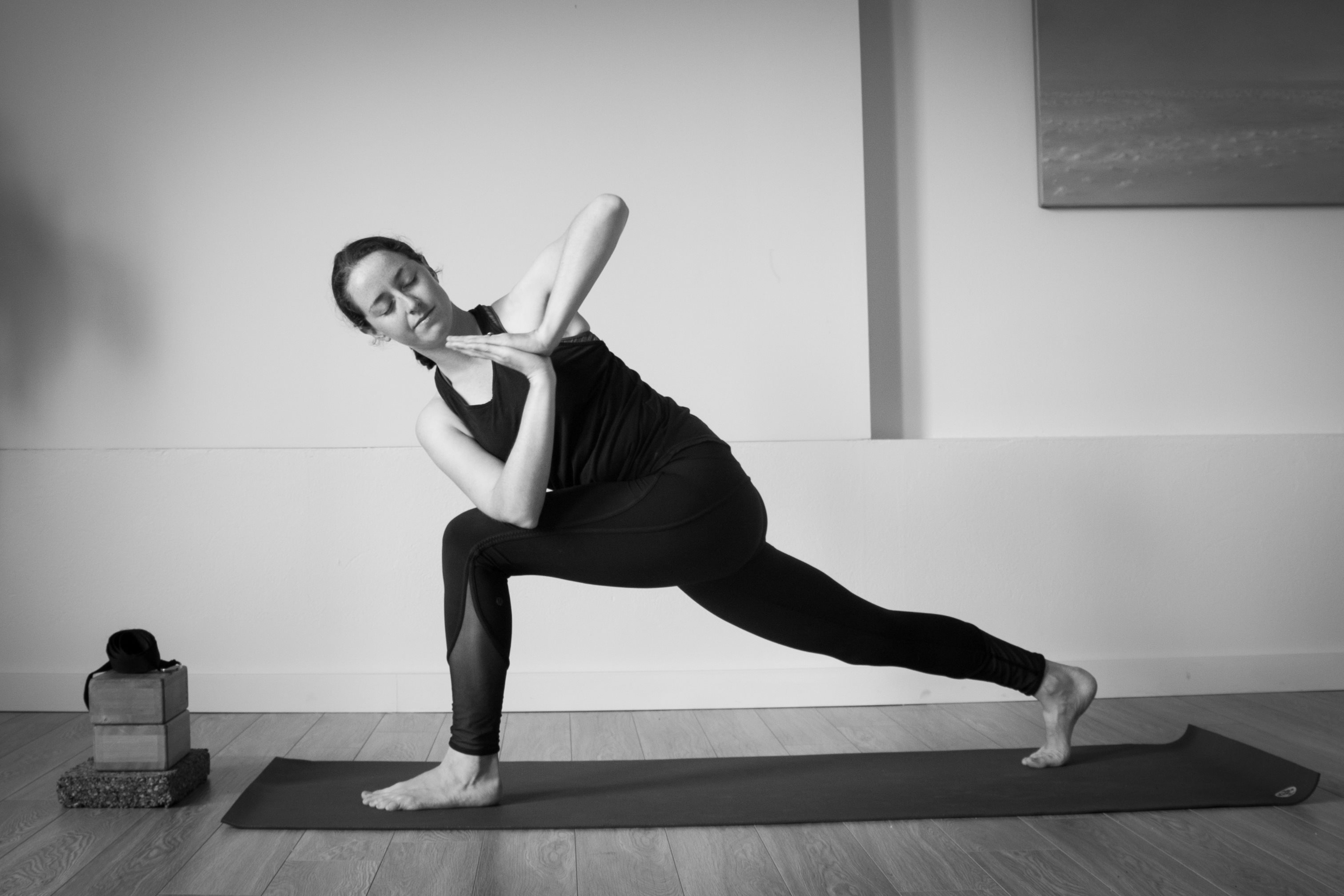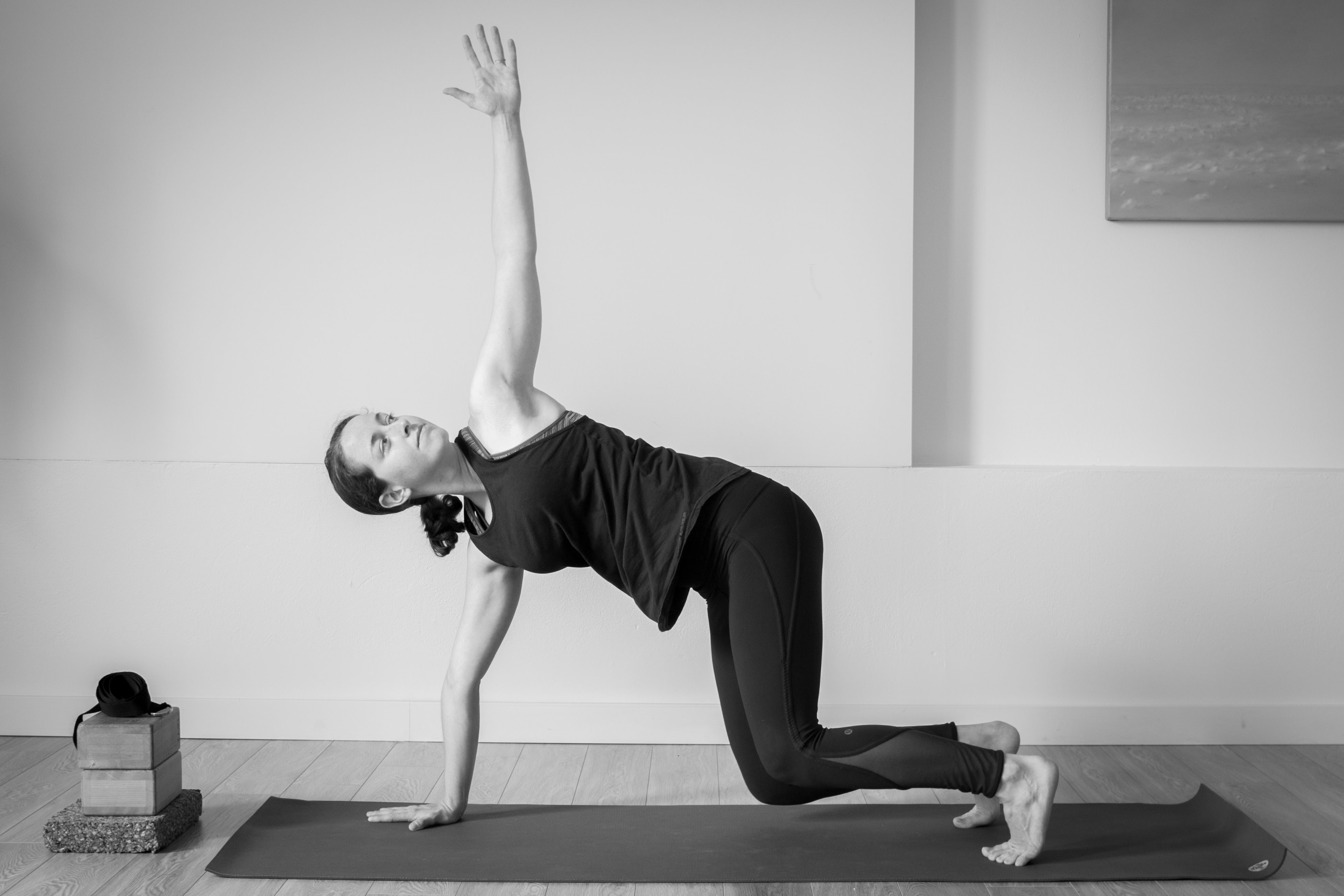Yoga teachers and practitioners know that great alignment cues can make all the difference in our practice. Unfortunately, some common cues undermine the body’s natural intelligence by interfering with the brain’s natural ability to direct movement patterns. One prime example of this has been written about ad nauseum: the glute softening cue (see here, here, and here). Specifically, many yogis have long been told to relax their glute muscles in backbends such as locust or bridge. But your glutes are actually responsible for extending your hips in those poses. So relaxing them during hip extension is absurdly counterproductive. While this oft-used cue takes the cake, today we will look at two other examples of verbal cues in yoga that interfere with our body’s natural intelligence and should be dropped from our cue tool belts.
Lift the pelvic floor
The pelvic floor muscles line the bottom of the pelvis and support the undercarriage of our torso. They naturally contract and relax during functional movement. Proper pelvic floor muscle function is necessary for stability of the pelvis and lumbar spine, support of the pelvic organs (i.e., bladder, uterus, rectum), all bathroom functions, and sexual function.1 Somehow, perhaps because of its relationship to Mula Bandha, the root energetic lock, some yogis have come to the conclusion that we should consciously be squeezing our pelvic floor muscles throughout practice. Not only is this contrary to the natural function of the muscles, but it may also contribute to holding patterns in the pelvic floor that can lead to a pelvic floor disorder!
Pelvic floor disorders encompass a set of conditions where the pelvic floor muscles fail to perform their tasks. They are extremely common — one study in the US found that almost one quarter of women have at least one type of pelvic floor disorder.2 The underlying causes of a pelvic floor disorder are vast and complex. According to the mainstream media, the global cure to any pelvic floor disorder is Kegels, Kegels, and more Kegels! Kegels are pelvic floor exercises used to strengthen the pelvic floor muscles. While Kegels and the like can be helpful for treating some pelvic floor disorders, they are not a widespread cure.3,4 This is because not all pelvic floor disorders stem from underactive pelvic floor muscles. In fact, there is a whole category of pelvic floor disorders where the problem lies with overactive pelvic floor muscles.1,4 These are aptly named “overactive pelvic floor disorders”.1

To make a long story short, understanding and treating pelvic floor disorders is complex and is best left to a specialist. Further, verbal cueing aimed at contracting the pelvic floor muscles is beyond the scope of what a yoga teacher is trained to do. The good news is, unless you are dealing with a pelvic floor disorder, in which case you should seek professional help, your pelvic floor muscles know what to do! Your brain has unconsciously learned how to contract and relax these muscles during a variety of movements since you first began to move, so it is unnecessary to consciously squeeze these muscles during your practice.
Draw Belly into Spine
The belly-to-spine cue, such as “pull your belly button towards your spine” is related to the second energic lock, Uddiyana Bandha, also known as the upward flying lock. You’ve probably heard this cue used in many poses such as downward dog, baby cobra, locust, mountain, and many more. In non-yoga circles, such as the physical therapy world, the belly-to-spine cue is described as a spine stabilizing maneuver called “abdominal hollowing”. Abdominal hollowing became a popular mechanism during exercise because of its supposed ability to activate the deepest of the abdominal muscles, the transverse abdominis. The transverse abdominis used to be considered the most important muscle for stabilizing the spine.5 So as you can imagine, abdominal hollowing was prescribed during exercise to improve spinal stability. More research into spinal stability, however, has led us to understand that spinal stability is not the responsibility of a single muscle, but rather the task of a large group of muscles acting in concert.6,7

While our understanding of the complex nature of spinal stability has progressed, the abdominal hollowing cue still lingers. Many studies have looked into the abdominal hollowing technique to see if it provides any benefit during exercise. The results, of course, are a mixed bag but the consensus seems to be that abdominal hollowing is unnecessary.8–11 So, if you hear this cue in class, you won’t be doing a disservice to your body to politely ignore it. That said, I also see no harm in embodying this cue — there is certainly no danger in abdominal hollowing. But why waste your precious energy — your body knows what to do!
Let Your Body Do Its Thing
We have seen two prime examples of how embodying traditional cues isn’t always helpful — the extra effort of squeezing your pelvic floor muscles or sucking your belly inwards doesn’t provide any benefit. Further, these actions can work against the body’s natural intelligence and may even cause problems down the road (i.e., overactive pelvic floor disorder). Avoiding these unnecessary cues creates less confusion for the body and allows the practitioner to save their limited mental and physical energy for the rest of their practice. Just remember, your body has been learning and moving your entire life — it knows what to do!
References
- Padoa A, Rosenbaum TY. The Overactive Pelvic Floor. (Padoa A, Rosenbaum TY, eds.). Cham: Springer International Publishing; 2016. doi:10.1007/978-3-319-22150-2.
- Nygaard I, Barber MD, Burgio KL, et al. Prevalence of Symptomatic Pelvic Floor Disorders in US Women. JAMA. 2008;300(11):1311. doi:10.1001/jama.300.11.1311.
- Butrick CW. Pelvic Floor Hypertonic Disorders: Identification and Management. Obstet Gynecol Clin North Am. 2009;36(3):707-722. doi:10.1016/J.OGC.2009.08.011.
- Faubion SS, Shuster LT, Bharucha AE. Recognition and management of nonrelaxing pelvic floor dysfunction. Mayo Clin Proc. 2012;87(2):187-193. doi:10.1016/j.mayocp.2011.09.004.
- Miller MI, Medeiros JM. Recruitment of internal oblique and transversus abdominis muscles during the eccentric phase of the curl-up exercise. Phys Ther. 1987;67(8):1213-1217. http://www.ncbi.nlm.nih.gov/pubmed/2956614. Accessed September 5, 2018.
- Mcgill SM, Grenier S, Kavcic N, Cholewicki J. Coordination of muscle activity to assure stability of the lumbar spine. J Electromyogr Kinesiol. 2003;13:353-359. doi:10.1016/S1050-6411(03)00043-9.
- Cholewicki J, VanVliet JJ. Relative contribution of trunk muscles to the stability of the lumbar spine during isometric exertions. Clin Biomech (Bristol, Avon). 2002;17(2):99-105. http://www.ncbi.nlm.nih.gov/pubmed/11832259. Accessed July 30, 2018.
- Grenier SG, McGill SM. Quantification of Lumbar Stability by Using 2 Different Abdominal Activation Strategies. Arch Phys Med Rehabil. 2007;88(1):54-62. doi:10.1016/j.apmr.2006.10.014.
- Vera-Garcia FJ, Elvira JLL, Brown SHM, McGill SM. Effects of abdominal stabilization maneuvers on the control of spine motion and stability against sudden trunk perturbations. J Electromyogr Kinesiol. 2007;17(5):556-567. doi:10.1016/j.jelekin.2006.07.004.
- Koumantakis GA, Watson PJ, Oldham JA. Trunk muscle stabilization training plus general exercise versus general exercise only: randomized controlled trial of patients with recurrent low back pain. Phys Ther. 2005;85(3):209-225. http://www.ncbi.nlm.nih.gov/pubmed/15733046. Accessed August 8, 2018.
- Kim D-W, Kim T-H. Effects of abdominal hollowing and abdominal bracing during side-lying hip abduction on the lateral rotation and muscle activity of the pelvis. J Exerc Rehabil. 2018;14(2):226-230. doi:10.12965/jer.1836102.051.

Illustration by Ksenia Sapunkova
Edited by Jaimee Hoefert, the Scientist Yogini
Enjoyed reading this article? Consider supporting us on Patreon or making a one-time donation. As little as $2 will allow us to publish many more amazing articles about yoga and mindfulness.



